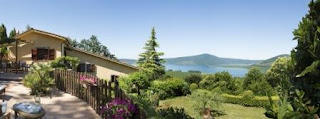 |
| Vitorchiano . medieval village near Rome |
 |
MOAI
monolithic sculptur created on Easter Islands |
The Vitorchiano's
MOAI
In the heart of the Lazio Mountains, barely an
hour from Rome, lies a medieval village. Its stone houses cling to the side of
gorge, spreading across the rock face like a tamed, civilized extension of the
mountain itself. Thick outer walls lend the look of the fortress.
Inside , there are quiet squares, silent
churches, cobbled streets: the very image of a gorgeous Italian
village.
To get there , you have to trek along the side
of the Cimini Mountains, where you can admire olive trees, pine trees and an
imposing Moai statue. Hold on !Rewind a
second. What on earth is a monolithic sculpture by the Rapa Nui doing in a
medieval Italian village ? Let’s discover the enigma !
The Moai are mysterious sculptures believed to
possess magical powers. They were created on Easter Islands between 700 A.D.
and 1600 A.D. as burial monuments, it is thought. By the 1990s, almost 900
different statues had been registered. But from that time onward, another
example, located in a small Italian village, had to be added to the list. And
it’s the only Moai sculpture anywhere outside Easter Island.
Its story begins in 1989, when a delegation of
12 Rapa Nui people from the Atan family , the island’s nobility, travelled to
Vitorchiano to celebrate the twinning of this village with Easter Island. Their
motive wasn’t so much to discover new cultures but to preserve their own: they
needed to finance restoration work on their sculptures , some of each was in a
dire state of repair. The unusual group visited the village and, quite
unexpectedly, found something in common with their home. It was a volcanic rock
that goes by the name of peperino. It’s
really hard on the outside and soft inside
, which make sit perfect for carving and ideal to stand erosion over time.
Peperino was used for centuries by
Vitorchiano’s builders.
In the Antient Rome : the cloaca Maxima, the
base of the Castel Sant’Angelo.
What nobody knews was that this material is
incredibly similar to the rock used 14,000km away to create some of the most famous sculptures
in the world.
In December 1989 , for a month, a group of
visitors, the Rapa Nui people from the most isolated spot on the planet, stayed
in the village and moved into the
village while a TV crew got the whole of Italy watching.
A film crew from Alla Ricerca dell’Arca, a
programme of Italian public television shared experience and cultural exchange
between two completely different communities.
The sculpture came came along at a lively pace
despite its dimensions: 6 metres in height and weighs 30 tonnes. When they
finished the colossus, it was transported
by crane to the village’s main
square and inaugurated with an atypical ceremony. The celebrations drew on Rapa
Nui customs, complete with ancient rites and ceremonies from the island.
In 2008 the statue was temporarily relocated.
It never returned to its original site.
After this event, Vitorchiano returned to be just as calm ,
peaceful and perfectly alive, as ever.
And life in this village goes on , under the attentive gaze of the last Moai.
 |
Accomodation in the apartments of Villa la Paiola
just a few minutes by car from Vitorchiano's Moai |



